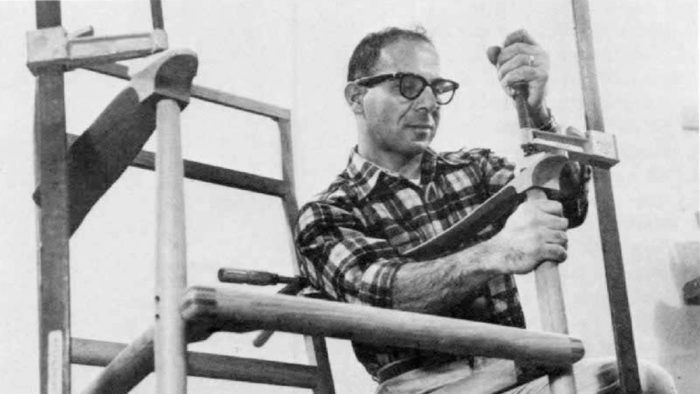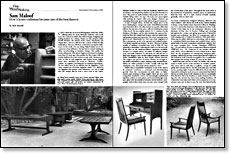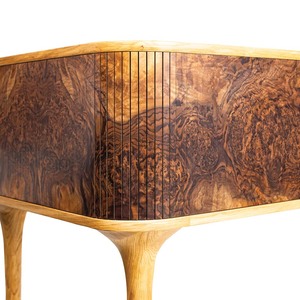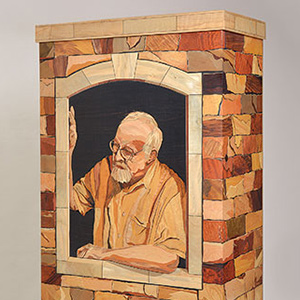Sam Maloof Interview
How a home craftsman became one of the best there is
Read the full text from Fine Woodworking‘s 1980 interview with Sam Maloof, or become a member to download the original PDF.
Call to mind the do-it-yourself magazines of the late 1940s, offering plans for boxy Masonite built-ins, and you’ll sense the context in which Sam Maloof began designing and making furniture for a living. Picture too the invasion of the Danish Modern, the advent of the “clean, functional, but elegant line,” and you will have the context of Maloof’s first marketplace. But you will have a hard time tracing the influences on his work. For one thing, Maloof claims not to be conscious of any influence. He has had no formal training in either woodworking or furniture design. The subtle but steady refinement of his pieces began in a backyard workshop more than 30 years ago; they predate his first contact with the Danish furniture his work seems in touch with. Numerous articles on him in craft magazines and Sunday home supplements have described his work as “Western,” “Gothic,” “classic” or “organic,” but Maloof is no student of art history.
He was asked once by an admirer was he Egyptian—”Your chairs remind me of ancient Egyptian chairs.” No, Maloof is not Egyptian (his parents were Lebanese), nor was it until after this remark that he took a close look at the Tutan-khamen exhibit in Cairo to find the similarity. Maloof is not an imitator, not tempted by trends to try the new because it is new. “My goal is to make furniture that people can be comfortable living with,” he says. “If you’re not preoccupied with making an impact with your designs, chances are something that looks good today will look good tomorrow.”
Simple values show through in his designs
A man of simple values, he feels the simple piece is the most challenging to design and make. Embellishments hide more than they show. He relies instead on a purity of line that follows the structure of the piece without violating the nature of the wood. He uses mainly walnut, No. 2 common for the liveliness of its figure, and he often includes the sapwood because he likes the contrast and because when he started making furniture walnut was expensive, 35¢ a foot, and why waste good wood? Characteristic too (he’s one of the originators of this contemporary motif) is his exposed and sculpted joinery.
“I’ve always exposed my joinery,” he says, “Why go to all that trouble of making a beautiful joint only to hide it?” He’s primarily a chairmaker, believing the chair to be the most difficult piece in the furniture-maker’s repertoire—probably because it is simply joinery. He makes 20 different designs now, each with variations. To stay fresh, he will add two or three new designs a year. He also makes casegoods, tables and desks, identifiable again by their simple, evident structure. The tongues and grooves of drawer dividers are brought to the surface and faired to shape, framing neatly recessed faces.
Tables are either pedestal or trestle, usually with legs like eucalyptus roots, their joints always pinned to view. There’s thus a remarkable consistency to his work—and in its coherent variations, a continual and discriminating growth. From the concentration in early chairs on latheturned pans meeting at sharp angles, there are now more compound, bandsawn curves. An increasingly sophisticated hard line, which on some pieces can be traced through every part, plays with the transition between curved surfaces. Intriguingly well-worked joints have become more integral with the overall shape of the piece. Throughout his work, there is the touchstone of symmetry—natural, exact, no matter how fluid the form. His is a style evolved of itself, carefully, gradually, with no dead ends.
The woodworker as celebrity
For many contemporary designer/craftsmen, Maloof is one who’s made it. He’s shown his work at the Vatican Museum in Rome, at the Smithsonian’s Renwick Gallery in Washington, D.C., and at the American Crafts Museum in New York.
Twelve of his chairs are in the permanent collection at the Museum of Fine Arts in Boston. Selling and showing throughout the country and giving generously of himself in lectures and workshops, his effect on contemporary crafts is wide-ranging and, to witness his imitators, often quite direct.
What may be called California woodworking, with its organic, sometimes flamboyant shapes and sculpted joints, can be traced back to its most conservative practitioner, Maloof. He’s 10 years younger than George Nakashima (FWW #14, Jan. ’79) and almost 30 years younger than Wharton Esherick (FWW #19, Nov. ’79). Unknown to one another until the early 1950s, and as distinctive as each of their work is, these three are the progenitors of contemporary designer/craftsmanship.
Maloof was the first woodworker elected a Fellow of the American Craft Council—recognition for a contribution that requires first having worked 25 years in the field. Maloof has years of work on order. He builds only what he wants to build, and he works and lives in enviable comfort. He’s never sold at crafts fairs or galleries, except for small group and one-man shows—his last (four years ago) was sold out on opening night. It may be difficult for those who find themselves striving for such success to understand that Maloof did not so much strive for his situation as live it committedly from the first. Since his decision to make furniture for a living, his sole income has been from making furniture. Of course there were lean years when a down payment on a commission came just in time to pay the rent. But Maloof really works no differently today than he did when he started. He has never had more than a couple of helpers; he has one now.
Made with his own hands
He does all his own designing, stock selection, joining, shaping, at least some sanding and finishing, even crating and sometimes delivery. He works a 60-hour week, producing 60 or 70 pieces a year, all of showpiece quality. Maloof has never compromised the value he places on working directly for his customers and on making his own designs with his own hands. When he started making furniture, post-World War II southern California was a furniture designer’s dream—one of the fastest growing, most affluent areas in the country. Other talented designers surveyed the situation and found it yielded best to prototypes that could be sold to furniture manufacturers for many times what an individual client would pay, and then often with royalties attached.
Maloof has been approached to do the same; one company once proposed making a million of his pieces. But Maloof maintains it’s not enough to be a designer only, that a design on paper is not a complete creation. Part of it must come from the craftsman who brings the idea into the real world. The changes it must necessarily go through, the little off here and the reconsideration of that curve there, the refinements that make the design right and give each piece its individuality, are important and fulfilling decisions. They’re also more fun than supervising an assembly line.
To design only or to build only from another’s designs for a mass market is to be out of touch with the whole of the process, which includes the customer. “I want to be able,” says Maloof, “to work a piece of wood into an object that contributes something beautiful and useful to everyday life. And I want to do this for an individual I can come to know as a friend. There’s more to life than making things. Each time someone who has one of my pieces sits on a chair, uses a table or opens a chest, I want that person to know it was made just for him and that there is satisfaction and enjoyment in the object for us both.”
He built a legacy in his home and studio
Maloof lives in Alta Loma at the foot of the San Gabriel mountains, about 50 miles east of Los Angeles. His seven acres, bordered by eucalyptus and avocado trees, include one of the few still-producing lemon groves in the area. He remembers when the surroundings flourished with the largest citrus farms and vineyards in the world. And though he is a native, born in Chino about 15 miles from where he now lives, he doesn’t have to go back more than ten years to tell how the building boom made his green-sheltered redwood hacienda an oasis of wood amid tracts of stucco houses, condominiums and shopping centers.
Maloof and his wife, Alfreda, who has managed the books, taken many of the photographs and been the hostess for the numerous house guests all these years, were married in 1948 and bought the property in 1952. Maloof was working as a graphic artist, doing silk-screens and scaling mosaic murals. He also drew for an architect. Before that were four years in the army. He’d taken to drawing in high school, the only schooling he’s had, and as early as 1934 was making furniture for his parents, using the high-school woodshop at night. His first table was made of discarded plywood from concrete forms. Soon after high school he worked a year for Bauhaus graduate Harold Graham, “one of the only industrial designers I know,” he says, “who could build what he designed.” Graham was responsible for the window displays at Bullocks department stores—elaborate, animated scenes made of a variety of materials that “opened up a whole new world” for Maloof. There was a well-equipped shop and a journeyman carpenter to work with, and after the Christmas displays were done, Maloof helped build the furniture for Graham’s house. All the while, both before and after his army service, Maloof built his own furniture on the side.
In 1952 he was 36. “There were two structures on the property when we moved in. We lived in what amounted to a shack where the guest house now stands. And I set up shop in a chicken coop with a dirt floor. But right from the start I knew exactly what I wanted.” While he and his wife raised a son and a daughter, Maloof learned what he had to about woodworking and built a house, addition by addition, until it is now eleven rooms surrounding a central court, not counting the three rooms that are his shop. And not counting too the four woodsheds (he has some 15,000 bd. ft. of wood), and of course the guest house. He built all these and thousands of pieces of furniture. More than 40 of them he still lives with; his home is his showroom.
Maloof inspired an entire generation of woodworkers
Now he works five or six days a week when he’s not away giving workshops (which he vows to do less because of the time and energy they consume); evenings and weekends might still find him working on the house. The actual time he manages to work in the shop varies. He will often work early, change his dusty clothes at lunch to run an errand or visit a customer, work in the afternoon again, all the while keeping an eye on the lemon grove. Feeling close to all he has made, he really does go to service his furniture. If a piece needs another coat of oil because its owner isn’t confident doing it himself, Maloof will find the time to oil it. In the shop he works on four or five projects at once. In the four days I was with him last May, he was working on a 6-ft. round pedestal table with a large lazy-susan center, a pigeonhole desk in brown oak, a couple of rocking chairs and a run of eight side chairs. He would rout the table parts round in the morning, fit the spindles for a rocker after lunch, and when his assistant, Jerry Marcotte, had sanded the surfaces of the desk, they would glue that up. The next day he’d bring them all a little further along.
A large man, not tall but broad and especially strong of hand, he works like the self-taught home craftsman he is, gone prolific with focused energy. He belt-sands and glues up wherever it’s convenient, usually on top of his table saw. He’ll sometimes sit on the saw too, shaping a chair part on his thigh with powerful rasp strokes. He supports his rocker spindles while filing for final fit in a notch worn 2 in. deep in a ratty old workbench; that’s one of the few times I saw him use the bench. He’s awfully handy with a router, holding it upside-down in one hand to round over the bottom edge of a desk top as readily as he held it upright for the top edge. Why turn the tabletop over when turning the router over is easier, especially when you’re used to working alone? On the band saw he can carve out a pair of compound-curved chair arms in five minutes.
At the end of another 15 minutes with rasps, Surform, files and scraper he will have a pair of arms symmetrical, as he says, “to within a hundredth of an inch—I use my fingers for calipers.” Templates deck the walls, but no jigs; this is how he easily varies his designs, and if a client wants the seat of his rocker an inch deeper, Maloof will do that too. It’s evident he enjoys what he’s doing. He never stops thinking about his work. Does he mind not having gone to school, not having had a sheltered time to explore and experiment?
“I’ve always experimented,” he says. “People just like what I do and buy it. As for schooling, my clients are my teachers. They’re the ones who bring me the design problems. Schools get too easily divorced from the real world. In many places students graduate and become teachers without ever making a living from their work. They grow stale. There’s a preciousness I see in a lot of student work that comes from having too many hours to put into it. Perfection is fine, and nothing has ever left my shop that I’m not proud of, but you have to produce if you’re going to make a living. I’ve heard people say they have to put a piece of wood aside until the spirit hits them. That’s procrastination.
Pick it up and work it—you’ll feel the spirit. No, I think it’s an advantage being self-taught. “I get a lot of visitors. Many young people starting out, also older people dissatisfied with their careers. They come with a picture or two of pieces they’ve done and they want to know if I think they can make it as woodworkers. It’s the romance of being a woodworker that attracts them, but a lot of them I don’t think really want to work wood. It’s very hard work. As for material security, if you’re happy within yourself, you don’t need a lot of things. I think anyone who knows what he wants to do and has faith in himself can do it. Talent, of course, is important too. Being a supersalesman goes only so far—you have to have something to sell. If it’s recognition you’re after, that tends to leave pretty quickly when it’s quick to come.
“I have a romantic view of what I do. I love wood and I love my tools. But I have a practical side too. I’ve made a living for more than 30 years as a woodworker—raised a family, built a home. It’s been good for me. It’s brought me in touch with a lot of people.”

Fine Woodworking Recommended Products


Compass

Sketchup Class





















Log in or create an account to post a comment.
Sign up Log in